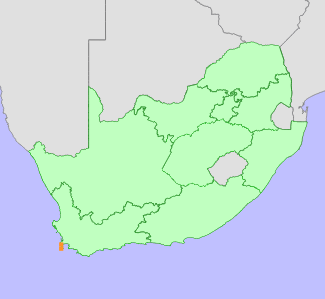|
Scientific Name | Erica halicacaba L. |
Higher Classification | Dicotyledons |
Family | ERICACEAE |
Common Names | Bladder Heath (e), Bladder-heath (e), Gooseberry Heath (e) |
National Status |
Status and Criteria | Rare |
Assessment Date | 2022/11/10 |
Assessor(s) | F. Munro & R.C. Turner |
Justification | A habitat specialist restricted to the southern section of Table Mountain National Park. It has an extent of occurrence (EOO) of 305 km². Its habitat specificity to rocky crevices means most of its subpopulations are protected from fire and the impacts of alien invasive plants. It is therefore listed as Rare nationally and Least Concern under the IUCN 3.1. Global Red List criteria. |
Distribution |
Endemism | South African endemic |
Provincial distribution | Western Cape |
Range | This species only occurs in the Cape Peninsula area in the Western Cape province of South Africa. |
Habitat and Ecology |
Major system | Terrestrial |
Major habitats | Peninsula Sandstone Fynbos |
Description | The habitat consists of rock crevices and ledges at mid-altitudes. |
Threats |
| This species may be susceptible to too frequent fire as it is single stemmed and long-lived. Its habitat specificity to rocky crevices, however, means that most of the subpopulations are protected from fire. While there are invasive aliens present within its range, its rocky crevice habitat is not the ideal habitat for invasives species and this pressure is also not suspected to be causing the population to decline. |
Population |
The populations was stable, as it was being surveyed by R.C. Turner, who by January 2009 had already recorded 1443 individuals. Many plants grow in inaccessible localities, e.g. south-facing cliffs on Noordhoek Peak and on Hout Bay Sentinel where there are several hundred inaccessible plants. As of 2022, the population is inferred to be stable as monitoring records between 2017 and 2022 documented by the Custodians of Rare and Endangered Wildflowers programme and iNaturalist do not record any decline to the population.
|
Population trend | Stable |
Assessment History |
Taxon assessed |
Status and Criteria |
Citation/Red List version | | Erica halicacaba L. | Least Concern | Raimondo et al. (2009) | |
Bibliography |
Goldblatt, P. and Manning, J.C. 2000. Cape Plants: A conspectus of the Cape Flora of South Africa. Strelitzia 9. National Botanical Institute, Cape Town.
Helme, N.A. and Trinder-Smith, T.H. 2006. The endemic flora of the Cape Peninsula, South Africa. South African Journal of Botany 72(2):205-210.
Raimondo, D., von Staden, L., Foden, W., Victor, J.E., Helme, N.A., Turner, R.C., Kamundi, D.A. and Manyama, P.A. 2009. Red List of South African Plants. Strelitzia 25. South African National Biodiversity Institute, Pretoria.
Schumann, D., Kirsten, G. and Oliver, E.G.H. 1992. Ericas of South Africa. Fernwood Press, Cape Town.
|
Citation |
| Munro, F. & Turner, R.C. 2022. Erica halicacaba L. National Assessment: Red List of South African Plants version . Accessed on 2025/09/21 |
 Comment on this assessment
Comment on this assessment

